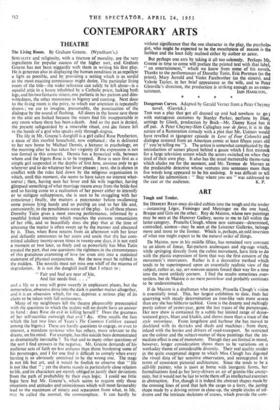ART
Tough and Tender.
SIR HERBERT READ once divided cubists into the tough and the tender —instancing Leger, Feininger and Metzinger on the one hand, Braque and Gris on the other. Roy de Maistre, whose new paintings may be seen at the Hanover Gallery, seems to me to fall within the latter category. Prunella Clough, whose new canvases—determined, controlled, austere—may be seen at the Leicester Galleries, belongs more and more to the former. Which is, perhaps, an odd inversion of what one might expect to be the natural order of things.
De Maistre, now in his middle fifties, has remained very constant to an idiom of linear, flat-pattern arabesques and zig-zags which, while springing directly from the cubist movement, have little to do with the plastic expression of form that was the first concern of the movement's innovators. Rather is it a decorative method which tends to be superimposed upon an essentially realistic view of the subject, rather as, say, art nouveau accents forced their way for a time into the most unlikely corners. I-find the results sometimes over- restless, but de Maistre is no mere pasticheur and prol?ably continues to be underestimated.
If de Maistre is a draftsman who paints, Prunella Clough's vision is essentially tonal. This, her largest exhibition to date, finds her quarrying with steady determination an iron-like vein more severe than any she has hitherto tackled. Gone is the dreamy and meltingly pretty colour of yester-year, gone the last traces of the picturesque. Her new show is contained by a subtle but limited range of dense- textured greys, blues and khakis, and shows more than a trace of the style mdcanique. From longshore and harbour she has moved to dockland with its derricks and sheds and machines ; from there, inland with the lorries and drivers of road-transport. So restricted are the colour and the subject-matter of these paintings that the im- mediate effect is one of monotony. Though they are limited in mood, however, longer consideration shows them to be variations on a workaday theme of considerable diversity. Their real quality resides in the quite exceptional degree to which Miss Clough has digested the visual data of her sensitive observation, and reintegrated it in terms of consistent pictorial architecture. Since she tends to be a still-life painter, who is post at home with inorganic forms, her formalisation lend-to her lorry-drivers an air of granite-like anony- mity, but it would not be fair to write them off as intellectual exercises in abstraction. For, though it is indeed the abstract shapes made by the crossing lines of cord that lash the cargo to a lorry, the jutting shape made by a driving mirror in close-up, the simple circles of oil- drums and the intricate skeletons of cranes, which provide the com- positional raison d'être of her work, Miss Clough's is a determined, disciplined, almost philosophic attempt to operate at several levels simultaneously—to relate the facts of observable life to the autono- mous demands of serious picture-making. One may sometimes wish that her brush were not always so rigidly controlled by her intelligence, that sometimes she would allow her feelings a little more play, but her efforts may well prove to be among the most fruitful of her generation.
Also at the Leicester Galleries are some pretty illustrations by Hanna Weil ; sincere and givilised drawings by Edmond X. Kapp ; views of an Australia becoming increasingly familiar by Sali Herman.
That the yeast of cubism is still active is perhaps shown as much by the current reaction against it as by such exhibition§ as the two already noted. Andre Minaux, at the new Adams Gallery in Davies Street, is one of the young French painters who marks a fashionable return to realism. He is in many ways akin to Buffet (to whom, however, he is five years senior) but has recently drawn further away from his earlier black-line compositions. His olive-greens and browns, his heavy impasto, his preoccupation with still-lifes of dead beasts, affect the spectator, however, with no less existentialist gloom, notwithstanding a certain uncouth strength. How wry different the atmosphere in Mr. Zwernmer's gallery off the Charing Cross Road, which he has reopened with a show of abstract and near-abstract paintings by Jan Le Witt ! Le Witt's vocabulary of shapes is not original or markedly personal. He stands rather at that same confluence of trends from central and western Europe which painters like Adler have found fruitful ground. Here he moves with ease, his mind freed to consider the colour harmonies that are his most remarkable gift. These sing and glow with tremendous élan. I found them tremendously stimulating.
Finally, there are a good many paintings—not masterpieces, the historians hasten to assure us—of the utmost charm among the 70 early English landscapes selected from Colonel M. H. Grant's immense collection, now arrived at the New Burlington Galleries from a tour of the provinces. The great names have been omitted ; many are all but unknown apart from the examples shown here ; but these plaited strands of topography, scene-painting and ideal Italianate romanticism together produced a school such as we have never had before or since in this country. I found especially attractive Nos. 10 (by Chinnery), 12, 18, 19 (a Roman scene of considerable grace by Eastlake), 27 (a remarkable view of Plymouth by A. B. Johns, friend of Calvert and Turner), 29 (by Lambert), 47, 49, 52 (by " Frost on the Thames " Samuel), 54, 60, 68 (by Wilkie) and 70. There are also two very curious expressionist landscapes by Lawrence—the only ones he is known to have painted.
M. H. MIDDLETON.



































 Previous page
Previous page